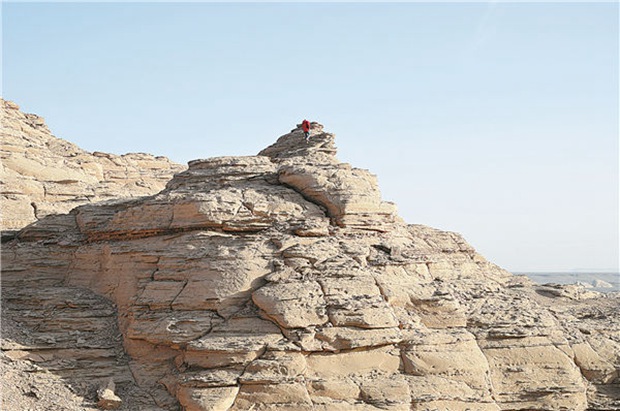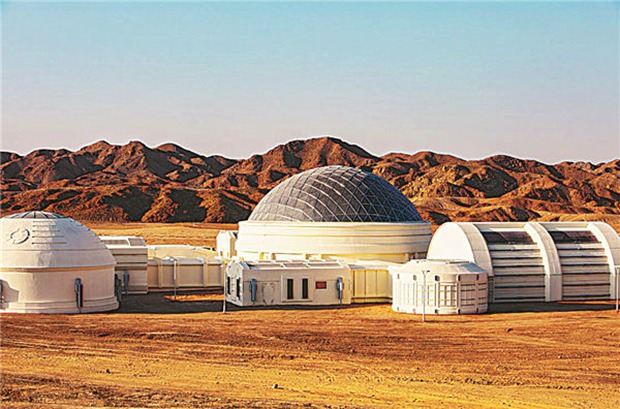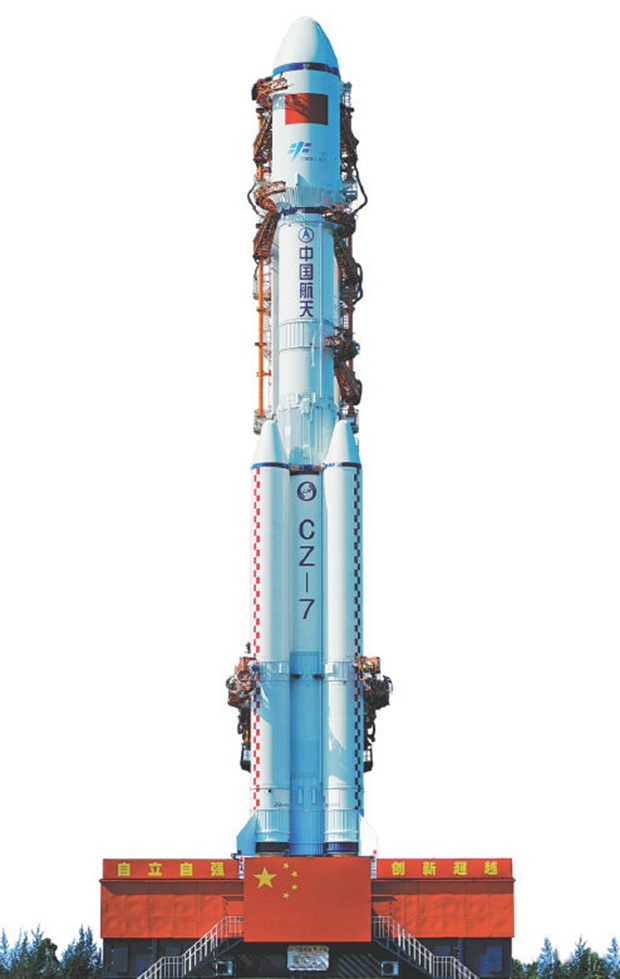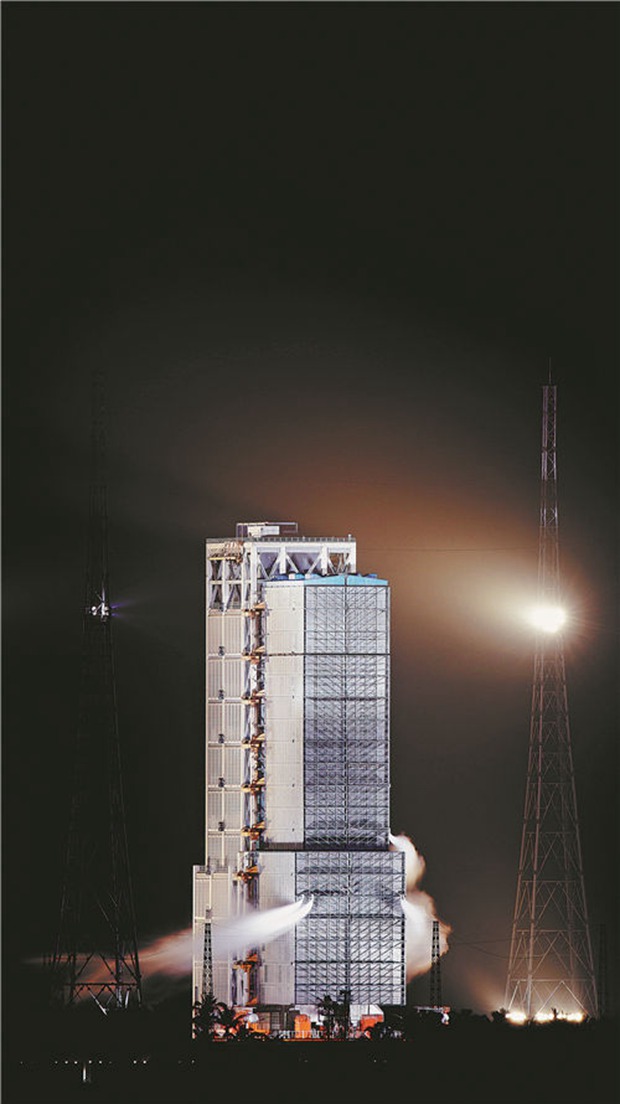Domestic travel services are looking to tap into China's lucrative sci-fi market by developing out-of-this-world holiday experiences, Xu Lin reports.
Xie Jixiao, 22, loves to watch rocket launches and record the excitement of such events with his camera. Despite living in Beijing, he's a frequent visitor to Wenchang Satellite Launch Center in Hainan province.
Although spectators are usually around 3 to 5 kilometers away from the launch platform, when the rocket ignites, he feels the ground shaking and the roar is so loud that it is as if he is standing next to it.

Mars Base 1 in the Gobi Desert in Jinchang, Gansu province, simulates the living environment of astronauts on the planet. [Photo provided to China Daily]
"It feels so close. Each time I watch a rocket launch, it is sci-fi made real, and I often burst into tears due to excitement, even though I've watched many times," says Xie.
"It's the best patriotic education. I think it shows our great national strength."
Once he watched a nighttime rocket launch and was overwhelmed by the scene of the heavy clouds being lit up by the roaring rocket.
Xie became a full-time aerospace photographer when he graduated from university last year. He's also a core member of SpaceLens, a group of young photographers, mostly university students, who like to record China's rocket launches in photos and videos.
Like him, there is a greater number of Chinese travelers planning trips to see rocket launches.
Also, some young spectators like to post photos of unique landforms in China online, claiming that "it's a trip where they can pretend they're on an alien planet". Some even pose for photos at such locations dressed in spacesuits.

The unevenly shaped Yardang landforms in Dahaidao, Hami city, the Xinjiang Uygur autonomous region. [Photo by Xu Lin/China Daily]
Guide to the galaxy
Such travel experiences can be found in A Travel Guide to Interstellar Space, a list of tips recently released online by Mafengwo, a travel service and social networking platform, in conjunction with monthly magazine Science Fiction World.
It includes aerospace museums, observatories and destinations that look like Mars. The Five-hundred-meter Aperture Spherical Radio Telescope in Pingtang, Guizhou province, is also among the attractions listed.
Both sides plan to co-organize themed activities, such as offline discussions, to integrate sci-fi with tourism.
Mafengwo is working with tourism operators to promote sci-fi-themed products on the platform, such as study tours and visits to planetariums, observatories and museums, with an informative tour commentary.
"The essence of tourism is exploration. The travel plans of humans will not always be restricted only to Earth. With the advanced development of science and technology, space travel is not beyond reach anymore," says Hong Runlei, who's in charge of Mafengwo's official travel tips.
She admits that the growing interest in aerospace and sci-fi among Chinese people in recent years was an incentive to produce the travel guide.
Last year witnessed great achievements in China's space program, ranging from the launch of the core module of its ambitious Tiangong space station project, to landing a rover on Mars. Also, China's 55 orbital launches in 2021 propelled the nation to the number one spot globally in terms of lift-offs.
In 2023, Chengdu in Southwest China's Sichuan province will host the 81st World Science Fiction Convention (Worldcon). The city is also the birthplace of Chinese sci-fi magazine Science Fiction World, in which Liu Cixin's The Three-Body Problem was first published in regular installments.
"As outbound travel is still restricted in China, it's important to explore the country's rich domestic tourism resources. Chinese visitors are longing for personalized and in-depth travel experiences," Hong says.

Mars Base 1 in the Gobi Desert in Jinchang, Gansu province, simulates the living environment of astronauts on the planet. [Photo provided to China Daily]
Red (planet) tourism
Mars Base 1 in the Gobi Desert of Jinchang city, Gansu province, where the topography is similar to that of the Red Planet, claims to be the only place in China that simulates the living environment of astronauts on Mars.
Located in the east part of the Hexi Corridor, it's about 300 km to the provincial capital of Lanzhou, with easy accessibility to nearby cities via road.
The project is supported by the Astronaut Center of China, cementing its scientific credentials.
The base's nine capsules, which offer different functionality, including the interior design, are modeled on authentic ones. In one capsule, seeds that once traveled into space have been planted there.
When Mars Base 1 was opened in 2018, it became the filming location of reality show Space Challenge, in which Chinese celebrities such as Wang Baoqiang and Zhang Yuqi simulated the experience of living on Mars for 13 days.
Currently, it's a place to popularize scientific knowledge about the aerospace industry and is only open for group bookings. Visitors are mostly aerospace experts, primary and middle school students, and government officials.
"It's like a simulated space station, for travelers to learn about the science of space exploration via on-site experiences with expert guides. You can see vividly what it would be like to live and work on Mars," says Duan Zhuochen, who's in charge of the base's promotional efforts on social media.
In July, it will be officially open as a scenic area to tourists, with various immersive experiences, as the second phase of construction will come to completion. There will also be a soft-opening in May, which travelers can apply to attend.
At the site, tourists can realize their dream of being an astronaut by wearing a spacesuit and operating instruments of a capsule and trying a machine that will allow visitors to experience a feeling of weightlessness. There are also restaurants, stores, a hotel and a camp site.
"We're very confident about its potential as a scenic spot, especially for youngsters who're longing for a unique travel experience," Duan says.
"There are also study tours to ignite the interest of students in aerospace."
Jinchang is not the only place in China that lays claim to "having a similar landscape to that of Mars".
The desolate scene of unevenly shaped Yardang landforms in Dahaidao, Hami city, the Xinjiang Uygur autonomous region, reminds visitors of the set of the Hollywood blockbuster The Martian.
There, the wind-eroded landscape of Yardang varies widely, creating escarpments and ridges that form shapes resembling great creatures and fantastic castle turrets.
Tourists travel through the desert region in hardy, off-road vehicles. Shutterbugs wait until nightfall and bear the cold to capture stunning images of the stars and the Milky Way.
In 2018, Ding Hong established "Mars Base", a well-equipped capsule hotel in Dahaidao for overnight guests. Before that, pitching a tent was the only option.
By 2023, his "New Mars Base" will be completed-it consists of a hotel, reception center and science and technology exhibition hall, with avant-garde designs that are just like the set of sci-fi movies.
"Dahaidao's great resemblance to Mars has helped it to gain fame as a destination. The new 'base' will continue to provide tourists with a Martian travel experience," he says.
Ding, an avid fan of sci-fi movies, was attracted to the unique landforms of Dahaidao during his first visit.
"It fulfills my curiosity about Mars," he says, adding that he decided to build his Mars Base, because he wants to "make sci-fi a reality".

Rockets at the Wenchang Satellite Launch Center in Hainan province. [Photo by Xie Jixiao/provided to China Daily]
To boldly go ...
He Qiongfeng, head of the Institute of Data Analysis, China Tourism Academy, says that the recently released travel guide can inspire destinations, scenic areas and tourism corporations to open up the niche market of sci-fi tourism, bringing more possibilities for the integration and innovation in the tourism industry.
"To develop sci-fi tourism, it's essential to integrate multiple subjects into it, ranging from science and technology to culture and art. Also, it's important to develop a variety of popular sci-fi tourism products with profound content, based on market research," he says.
In September, the 2021 China Sci-fi Industry Report revealed that, the total value of the industry in 2020 was over 55.1 billion yuan ($8.68 billion), of which sci-fi games accounted for about 87 percent.
He suggests that the tourism industry work with the producers of sci-fi video games, literature, TV series and movies to design themed products, noting that it's also a way to promote Chinese sci-fi culture.
"If the gap between tourists' expectation before travel and during trips is too big, they are likely to complain about their unpleasant experience, putting the reputation of scenic areas and destinations at stake," he says.
He suggests that destinations, scenic areas and tourism corporations avoid exaggerated promotion and focus more on the local culture, history and customs. They should also make a contingency plan in case there are complaints from tourists.

Rockets at the Wenchang Satellite Launch Center in Hainan province. [Photo by Xie Jixiao/provided to China Daily]














